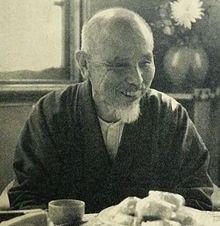Sakamoto Hanjirō
Sakamoto Hanjirō ( Japanese 坂 本 繁 二郎 ; March 2, 1882 in Kurume , Fukuoka Prefecture - July 14, 1969 ) was a Japanese painter of the Yōga direction .
life and work
In 1901 Sakamoto went to Tokyo with his friend Aoki Shigeru , who was also from Kurume, to study painting under Koyama Shōtarō ( ar 正 太郎 ) at his school Fudō-sha and at the art school of Taiheiyō Gakai ( 太平洋 画 会 ). He showed his pictures early in the exhibitions of the Teiheiyō Gakai , as well as in the 4th and 5th exhibition of the Ministry of Culture , Bunten ( 文 展 ), where he won prizes for his works “Drying Clothes” ( 張 物 ) in 1910 and 1911 as part of the latter , Harimono ) and “Coast” ( 海岸 , Kaigan ). At the 6th colorful exhibition in 1912, Natsume Sōseki was made aware of his oil painting "Subdued Sunlight" ( 薄 れ 日 , Usurebi ), which made him famous in one fell swoop. During this time Sakamoto worked with Yamamoto Kanae on the publication of the magazine Hōsun ( 方寸 ).
In 1914 Sakamoto was one of the founders of the Nika-kai artists' association and in the following years exhibited works in the style he had found, which is characterized by weak contours and lightly graduated colors. During his stay in France from 1921 to 1924 he further developed his style. Works from this period are “Brittany Landscape” ( ブ ル タ ー ニ ュ 風景 , Burutānyu fūkei ) and “Woman with Hat” ( 帽子 を 持 て る 女 , Bōshi o moteru onna ). After his return he avoided the big city and returned to Kurume. In 1931 he settled in Yame, Fukuoka Prefecture, where he spent the rest of his life. For a while horses were his main subject, during the 1940s he painted still lifes with subjects from his surroundings. In 1944 he withdrew from the Nika-kai.
After the war Sakamoto occupied himself with the Nō , whose masks he captured in pictures. In 1946 he was elected to the Academy of Arts , but refused to join. He did not join any artists' association and exhibited independently. In 1948 Sakamoto had a series of color woodcuts printed with landscapes made up of clear surfaces. In his final years he received several awards: He received the Grand Prize for Art from the Mainichi Shimbun newspaper in 1954 , the Japanese Order of Culture in 1956 and the Asahi Shimbun newspaper's Asahi Culture Prize in 1963 , but continued to stay away from the art world.
Other works by Sakamoto are: "Cows on the coast" ( 海岸 の 牛 , Kaigan no ushi , 1914), "Paris suburbs" ( パ リ 郊外 , Pari kōgai , 1923), "Three grazing horses" ( 放牧 三 馬 , Hōboku samba , 1932), “Horse coming out of the water” ( 水 よ り 上 が る 馬 , Mizu yori agaru uma , 1937), “Wall” ( 壁 , Kabe , 1954) and “Moon” ( 月 , Tsuki , 1967).
literature
- Japan Foundation (Ed.): Japanese Painting in the Western Style, 19th and 20th Centuries. Exhibition catalog, Cologne, 1985.
- Tazawa Yutaka: Biographical Dictionary of Japanese Art . Kodansha International, 1981, ISBN 0-87011-488-3 .
- Laurance P. Roberts: A Dictionary of Japanese Artists. Weatherhill, 1976, ISBN 0-8348-0113-2 .
Remarks
- ↑ This picture shows a landscape with a cow in subdued daylight in a light Art Nouveau style.
- ↑ Mainichi bijutsushō . Not to be confused with the Mainichi Art Prize ( Mainichi geijutsushō ).
| personal data | |
|---|---|
| SURNAME | Sakamoto, Hanjirō |
| ALTERNATIVE NAMES | 坂 本 繁 二郎 (Japanese) |
| BRIEF DESCRIPTION | Japanese painter |
| DATE OF BIRTH | March 2, 1882 |
| PLACE OF BIRTH | Kurume |
| DATE OF DEATH | July 14, 1969 |
